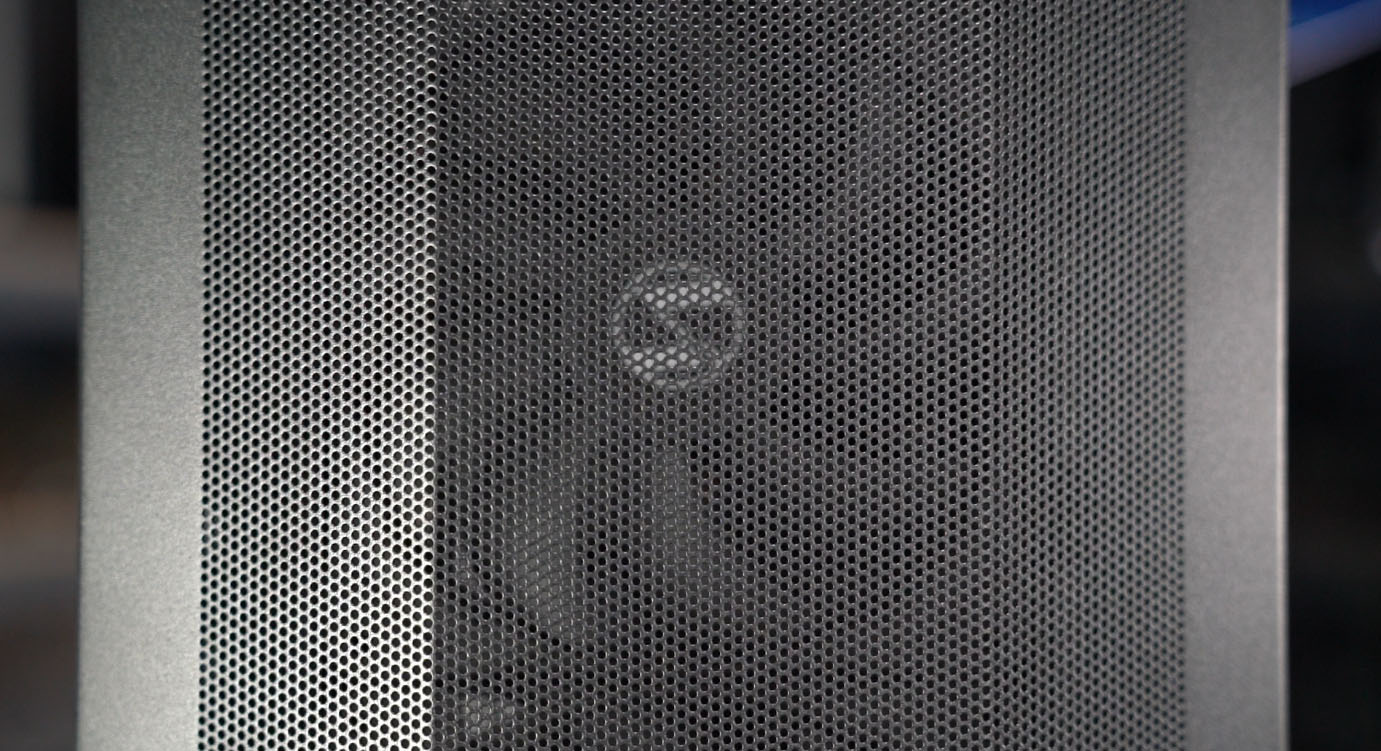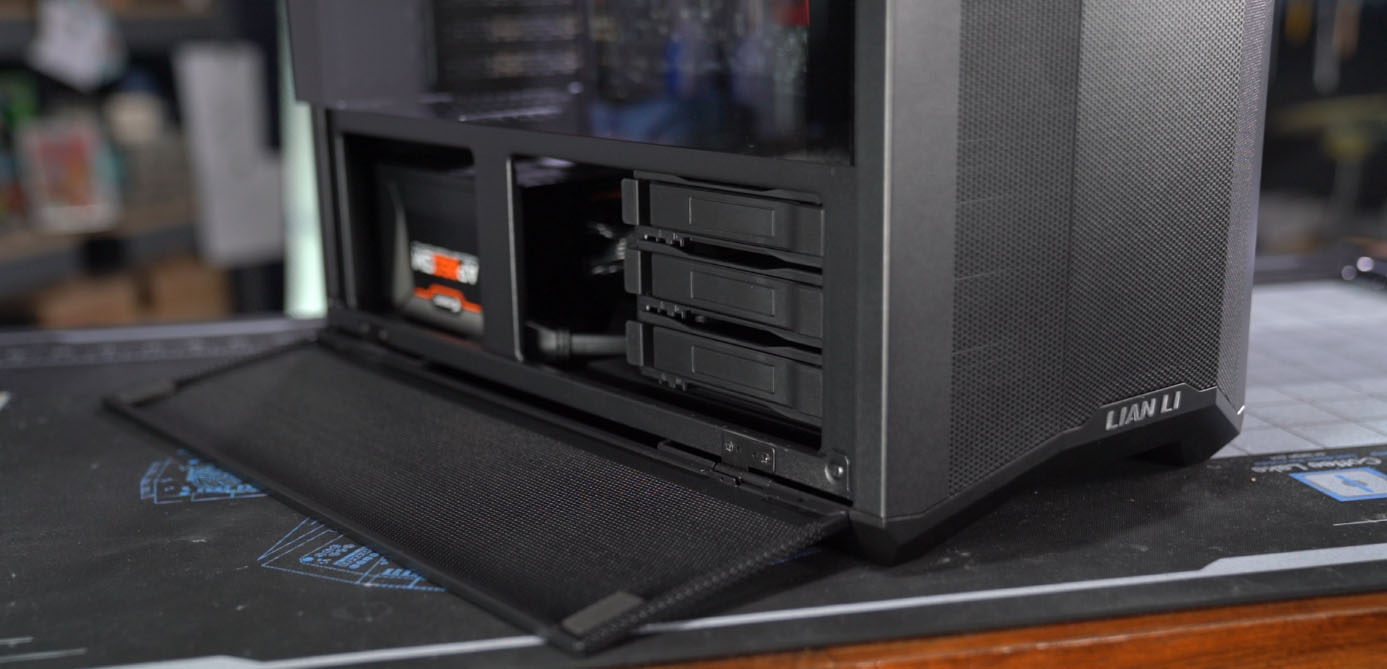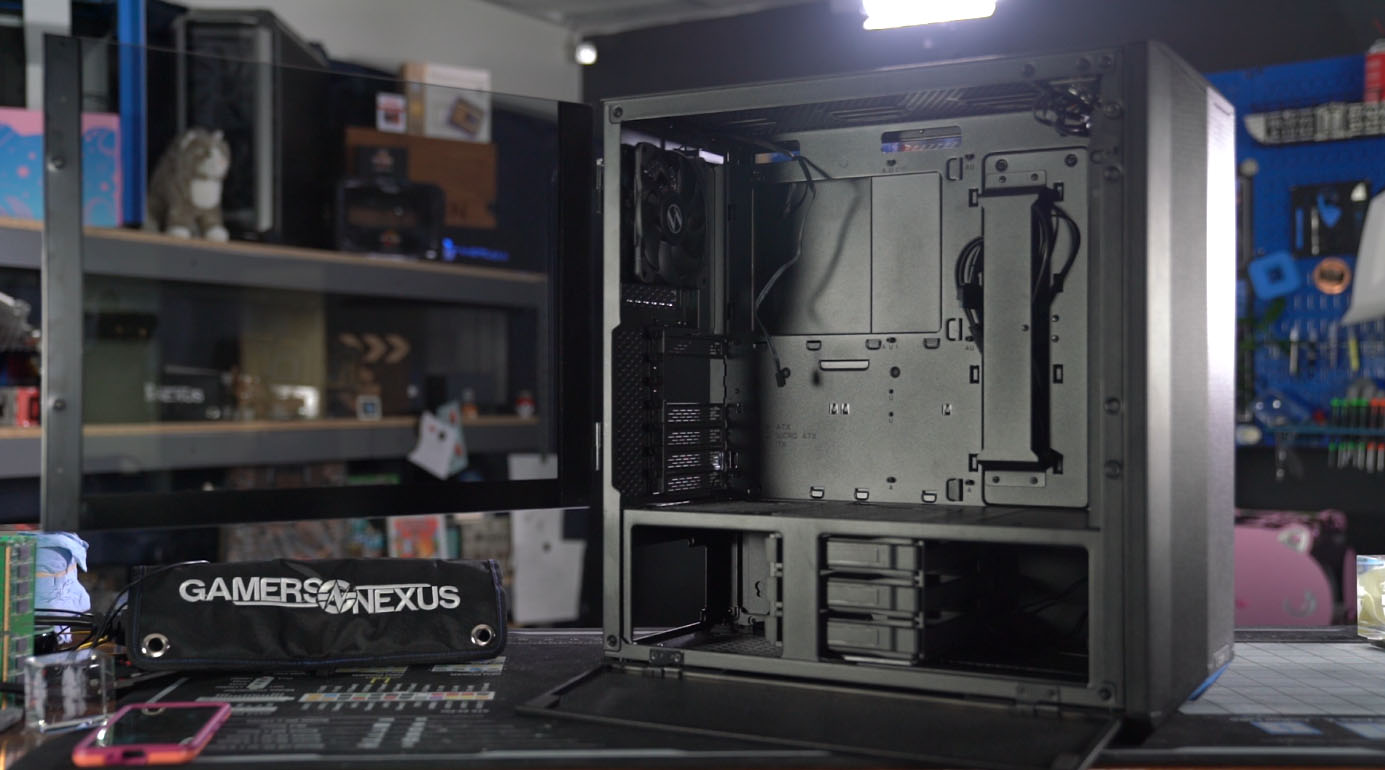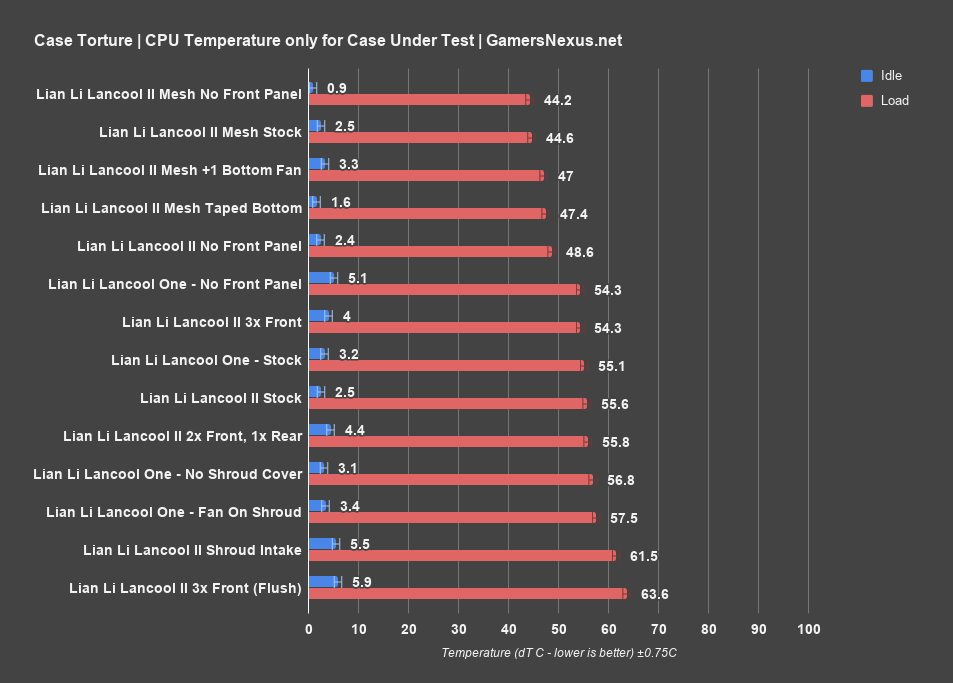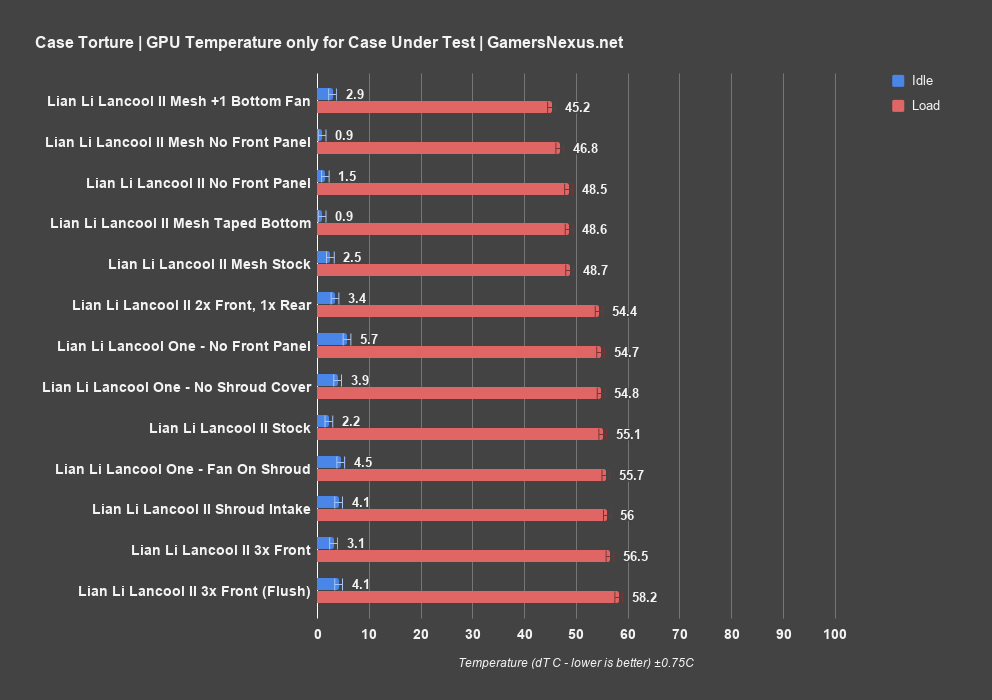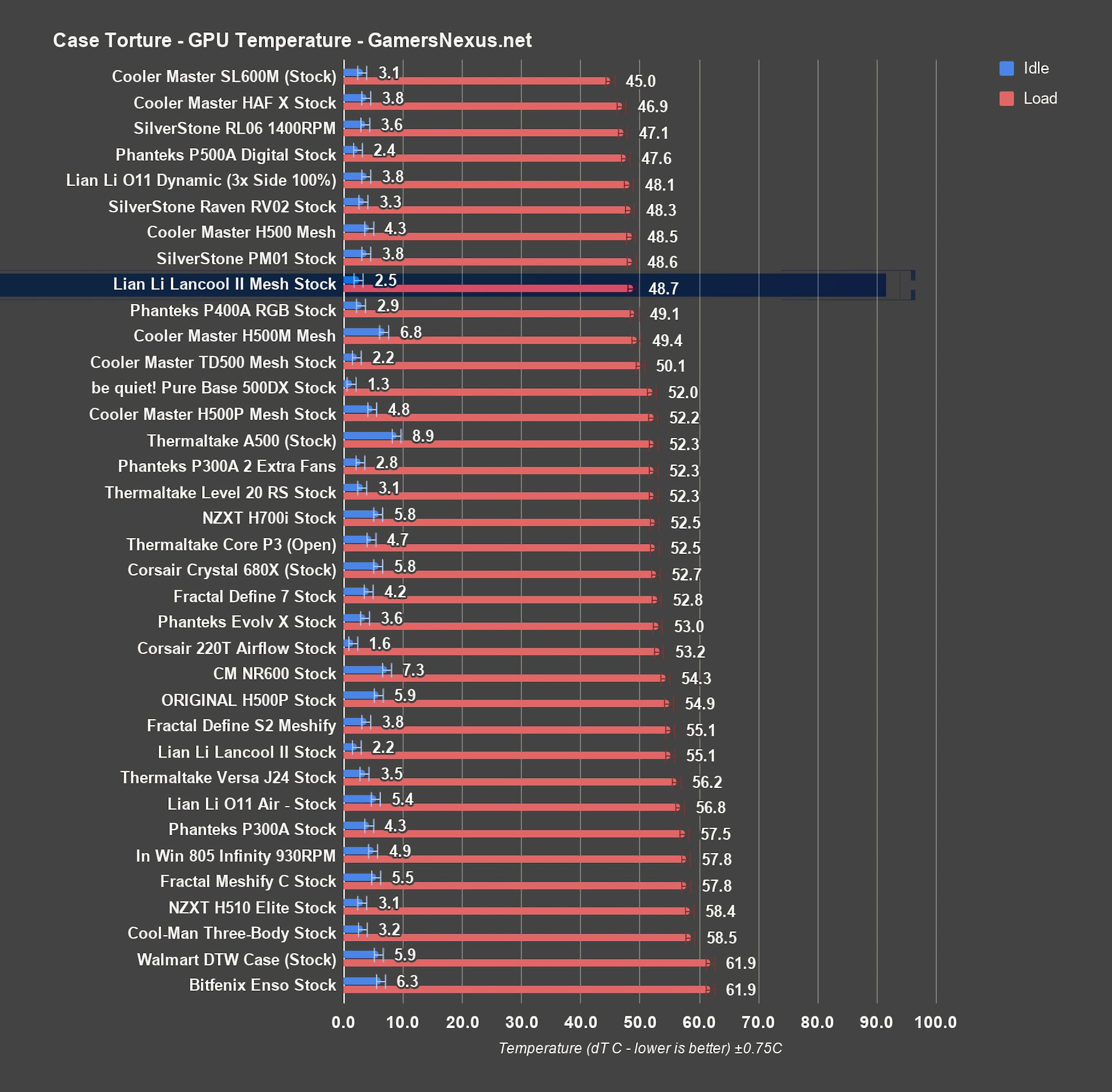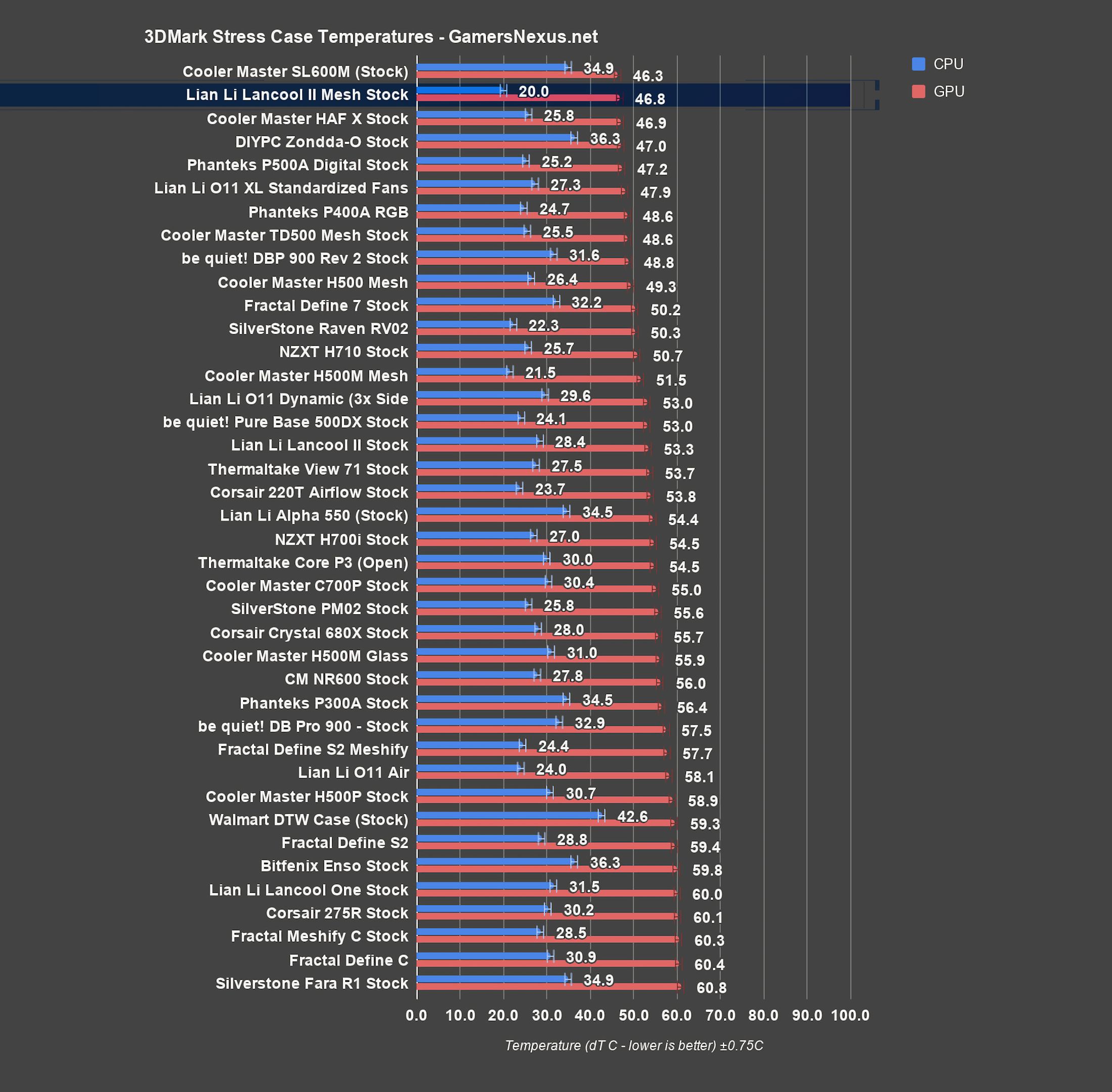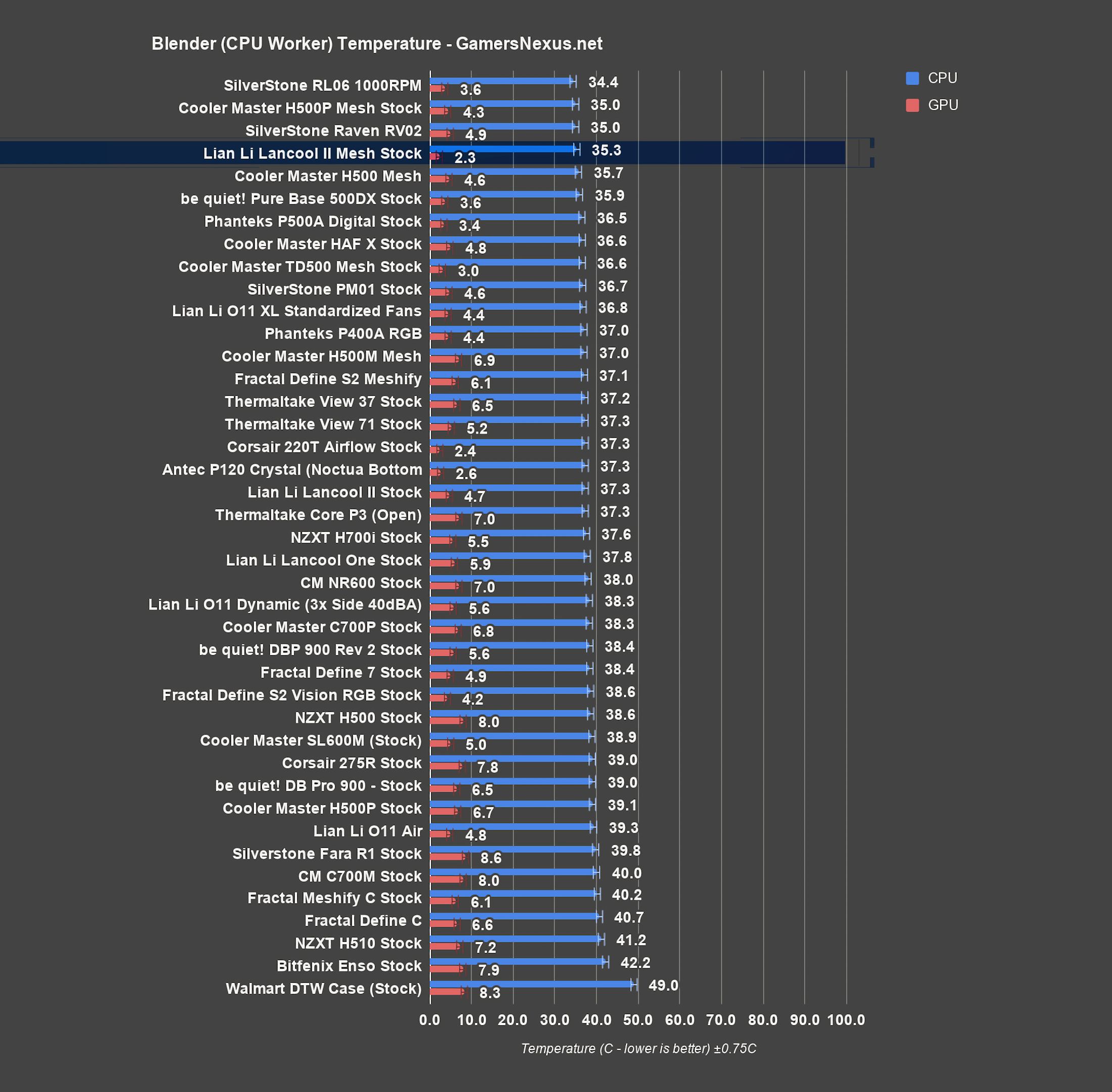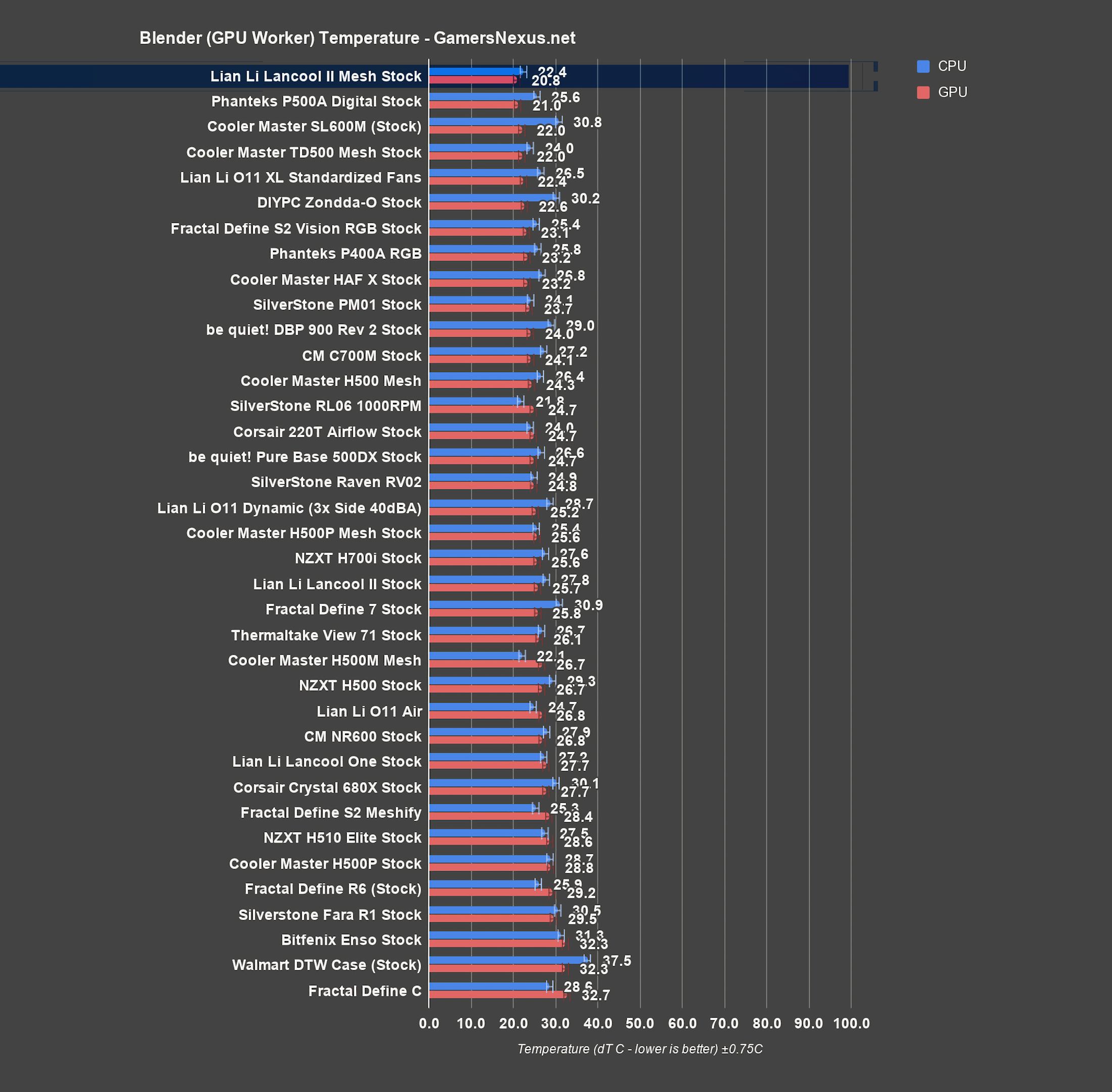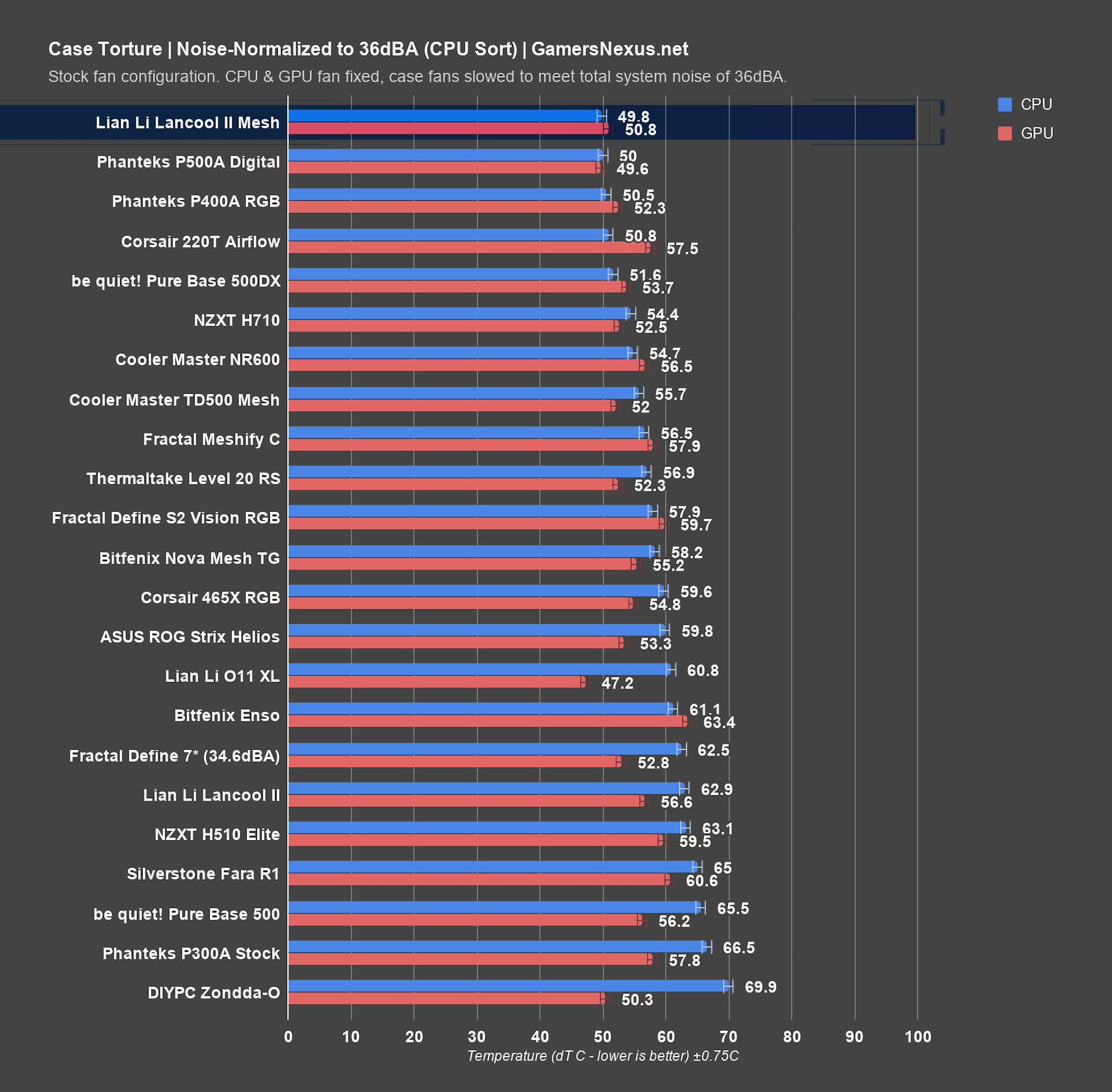The Lian Li Lancool II Mesh is a revision of the original Lancool II, which we reviewed in December of last year. For the most part, the Mesh is a simple panel swap, so the build notes from that earlier coverage still apply. We first saw the prototype Mesh edition during our tour of Lian Li’s Taiwanese factories earlier this year, and the updates we discussed back then have made their way to the final product. We’ll mostly limit this build section to differences from the original case.
As a reminder, the Lancool II is a chassis that already exists and was already reviewed, but this mesh version makes significant changes to the exterior paneling. For these reasons, we won’t fully recap our build quality thoughts from the original review, but we will go back over what has been addressed by Lian Li. This means that, for the complete picture, you should also check our original Lancool II review.
The Build
First, let’s cover some complaints we had with the original version that have been resolved. The hard drive cages in our first Lancool II sample were falling apart at the hinges; like many problems, it was nothing a little hammering couldn’t fix, but that hammering should have been done at the factory. The sleds in our L2 Mesh are exactly the same design, but assembled properly this time. We can’t say for sure that the problem is fixed based on a single unit, but it’s a start.
The four door sections on Lancool II cases are held shut with magnets. On the original Lancool II these magnets were left bare, so that if they weren’t tucked carefully into the corners during assembly they could smack against the metal chassis and chip. Even if they didn’t, the lower doors would slam shut, steel against steel. On the Mesh, these magnets are covered with foam pads that protect them and cushion the impact slightly.
Those are the fixes we wanted, but Lian Li has also made some other changes. The first and most obvious is the front panel, which is now steel mesh over a plastic frame with no backing filter, a style that we’ve seen increasingly often lately. The Cooler Master TD500 case, the NR600, and the Phanteks A-series cases have all started moving toward similar designs. The front panel of the Mesh is considerably simpler than the original, which was a fairly elaborate construction with two sections of ARGB lighting.
The original case had two 120mm fan mounts on top of the PSU shroud directly underneath the GPU, and the Mesh expands on this feature. There are open 120mm holes in the shroud for unobstructed airflow, which can be covered with perforated steel plates when not in use. The steel side panel that formerly had a small intake vent is now made entirely of mesh, making the shroud-top fan mounts much more usable. Lian Li informed us during our visit this year that the final version of this mesh section would be more reinforced than the prototype, and it is, but it’s still much more flexible and prone to warping than the solid steel panel on the other side of the case. There’s a tradeoff being made here, but we believe it’s worth it. The Mesh’s legs are canted inwards, which allows the lower doors to open fully without pinching the legs.
The ventilation holes used throughout the Lancool II were originally elongated ovals. Wikipedia informs us that this shape can be called a stadium, obround, discorectangle, or sausage body, but it’s so hard to choose. We’ll go with sausage bodies. These sausage bodies have been replaced by a honeycomb pattern in most locations except underneath the PSU, which according to Lian Li should allow more air through. It makes sense: the new pattern has a higher hole-to-metal ratio.
No RGB means no RGB controller, and Lian Li has repurposed the front panel space formerly used for lighting controls to hold a fan speed slider. The hub it’s connected to has six four-pin PWM connectors and three speed settings, as well as an “auto” setting that controls fan speed based on a PWM signal from the motherboard. We prefer to connect individual fans to individual motherboard headers, and we always do so for case testing, but as far as fan hubs go, this one is pleasantly minimalistic.
There were several small issues that we had with the original case that haven’t changed. To start, magnets remain the only thing holding each of the doors shut. We like magnets, but there’s no way to fully secure the doors, either for moving the case around or to prevent big wads of cables from pushing the sides open. The glass doors can still only be opened by first opening the lower steel doors, and the steel doors can only be opened from the back of the case. Finally, there’s still just an empty hole in the front I/O where an optional USB-C port can be installed. USB-C cables are available for purchase from Lian Li separately. Maybe this is a good way to give a discount to customers who don’t want a USB-C port (e.g. everyone who works here), but it just feels bad to buy a case with an empty hole for a feature it doesn’t have. We’d prefer a preinstalled USB type-A port that could be replaced with USB-C, for example.
Our first Lancool II review was posted before our “EATX is a lie” piece, so we didn’t give it any grief at the time over claiming EATX support. Flipping the cable management bar creates some extra room for motherboards up to 280mm wide. SSI-CEB boards will fit, SSI-EEB boards will not. Even with normal ATX boards, the stock placement of the cable management bar puts it very close to the edge of the motherboard, making it somewhat difficult to route the 24-pin power connector neatly.
That’s all old news- the biggest flaw that’s new to the Lancool II Mesh is a big hole at the bottom of the front panel. This wasn’t present in the original case, but for some reason the handle at the bottom of the Mesh’s front panel isn’t sealed off from the front intake fans. Using one layer of metal mesh without a filter for the front panel is fine, and we consider this the ideal compromise between high airflow and keeping dust out. Using one layer of metal mesh with a big open-air gap that circumvents it is just pointless, especially at the bottom, where dust likely collects. We’d recommend taping off this hole for long-term use--it’s hidden underneath the case, so it won’t affect the case’s appearance. Dust will affect long-term performance, though, and you can watch our dust thermal benchmark for that.
One feature that hasn’t changed is the removable front fan/radiator mount, but it’s nice and we’d like to mention it again. It can be flipped around and repositioned to move fans closer to or further from the front panel in small increments, either for better airflow or radiator clearance. The case ships with the stock fans mounted flush with the front of the chassis. We don’t recommend mounting radiators larger than 280mm in this case: the front just barely has space for a 360mm rad, and probably only with the tubes up, which is inadvisable since it creates pump whine and water starvation after permeation sets in. The drive cage is repositionable and removable, but there’s already limited space to work with under the shroud without adding fans and radiators into the mix. Clearance from the top edge of the motherboard to the top of the case is just slightly over 3cm, so narrow 120mm radiators that can be offset away from the motherboard are recommended for top mounting.
The Mesh is compatible with the same separately purchased addons as the regular Lancool II, like a hot-swap HDD backplane and a vertical GPU mounting kit. Check our original review for more details on these features, but our opinion is that they don’t add significantly to the value of the case.
GN Case Testing Bench
| Component | Courtesy Of | |
| Video Card | MSI GTX 1080 Gaming X (OC Mode) | MSI |
| CPU | Intel i7-6700K @ 4.4GHz | GamersNexus |
| CPU Cooler | MSI Core Frozr L | MSI |
| Motherboard | MSI Z170A Gaming M7 | MSI |
| Memory | Corsair Vengeance LED 32GB 3200MHz | Corsair |
| SSD | Samsung 850 EVO 120GB | Samsung |
| PSU | Gigabyte 800W PSU | Gigabyte |
| Cables | CableMod Pro Mesh Cables | CableMod |
| Case | This is what we're testing! | - |
The video card is configured to run at 55% fan speed at all times.
Prior to load testing, we collect idle temperature results for ten minutes to determine the unloaded cooling performance of a case's fans and air channels. Thermal benchmarking is conducted for 1400 seconds (23 minutes), a period we've determined sufficient for achieving equilibrium. The over-time data is aggregated and will occasionally be compiled into charts, if interesting or relevant. The equilibrium performance is averaged to create the below charts.
Load testing is conducted using Prime95 LFFTs and Kombustor “FurMark” stress testing simultaneously. Testing is completely automated using in-house scripting, and executes with perfect accuracy on every run.
Find our noise normalized & fan normalized testing methodology here: https://www.gamersnexus.net/guides/3477-case-fan-standardization-tests-noise-normalized-thermals
Thermals & Noise
We did a lot of tests with the original Lancool II, prior to the Mesh version, including rearranging the three 120mm stock fans throughout the case for different airflow patterns. Our main issues with the Lancool II original case were related to thermals, and so those were our attempts to fix the problem. The Mesh is slightly less reconfigurable, since two of the stock fans are 140mm and therefore will not fit on the mounts on top of the PSU shroud. We did our full suite of tests on the Mesh, as well as one test with a generic NZXT case fan added in on top of the shroud in the mount furthest back in the case as intake, and one test with the hole at the bottom of the front panel taped shut.
CPU Torture
We’ll start with data for only the Lancool series, then we’ll look at the comparative tests versus other cases. Baseline temperature for the CPU in our combined torture test was 45 degrees Celsius over ambient, which fell a fraction of one degree with the front panel removed, rounding to 44 degrees over ambient. Even before comparing this result to other cases, that’s a huge achievement--even cases with the least restrictive front panels see improvements of a few degrees with the front panel removed. The P400A RGB, not shown here but for example, improved its CPU temperature delta by four degrees. Taping shut the bottom of the Lancool II Mesh’s front panel helps to explain what’s happening: the CPU averaged 47 degrees over ambient with this modification, and so it turns out that leaving an open hole at the bottom is good for airflow, even if it’s not a good idea overall. Although we advocate for airflow, we don’t do generally recommend that cases which otherwise filter dust should leave giant holes in them, because it sort of invalidates all the dust control work done elsewhere. Don’t let that temperature difference distract from the fact that this is still only three degrees higher than baseline. Putting an extra fan in the case below the GPU understandably pushed the CPU’s average delta up a few degrees from baseline to 47 degrees Celsius, as hot air from the GPU was pushed upwards in the case towards the CPU cooler, and the pressure systems within the case have now drastically changed. More on that in the GPU section. Compared to the Lancool II non-mesh, all results are significantly better. The Lancool II non-Mesh without a front panel is actually warmer than the worst of the Lancool II Mesh results.
The original Lancool II averaged 56 degrees Celsius over ambient, nowhere close to the Mesh’s performance. Not much IS close to the Mesh’s performance, in fact, with the only stock result higher on the chart being Silverstone’s RV02. The H500M Mesh averaged 46 degrees and the RL06 averaged 48, and the rest of the stock results go up from there. Even if we say that the bottom of the front panel should be taped off and therefore that result should be counted as stock, that ties the Lancool II Mesh with the second-best stock result on the whole chart, beating out cases that occupy a similar price space, like the Phanteks P400A, Cooler Master TD500 Mesh, and be quiet! Pure Base 500DX.
GPU Torture
GPU temperatures were less affected by the restriction of airflow coming through the bottom of the front panel. Average temperature was 49 degrees Celsius above ambient whether the hole was closed or not. Adding the extra bottom fan did help, which may sound like the logical outcome, but we’ve run into instances where the GPU pulls air in through the rear of the case when left to its own devices, and performs worse when this airflow pattern is altered. Here, the GPU dropped down to 45 degrees Celsius over ambient with the additional cooling. The original Lancool II was, at very best, at 54 degrees over ambient with the best fan configuration we arranged. In the original Lancool II, we did one test with a stock fan moved to the top of the PSU shroud, with the result that both CPU and GPU temperatures got worse. Even though the same fan mounting locations exist in the original Lancool II, they’re too restricted to be of much benefit. In the Mesh, they do have enough ventilation to be beneficial if users choose to install fans here.
Moving to the comparative chart, the baseline GPU temperature delta is again far better than the original Lancool II, which averaged 55 degrees Celsius, but the stock Mesh’s GPU temperature doesn’t completely top the chart the way the CPU temperature did. Instead, it’s tied with several extremely respectable cases like the Silverstone PM01, the P400A, and the H500M Mesh, with cases that have direct GPU cooling like the HAF X and the SL600M retaining the top positions. Note that putting a fan on the PSU shroud pushes the L2M up to this same level of performance, as shown in the previous chart.
Firestrike
The Firestrike Extreme stress test places relatively little load on the CPU, meaning that hot exhaust from the CPU cooler can’t affect GPU thermals as much as it can in the torture test. Average GPU temperature in this test was 47 degrees Celsius over ambient, a little cooler than the baseline of 49 degrees over ambient. This is an extremely good result, on par with the cases that beat it in the torture test like the HAF X and SL600M. Thermals have been great across the board for the Lancool 2 Mesh, but GPU thermals can be even better when the system is partially loaded (or when an extra fan is added to the top of the shroud). The Lancool II Mesh is within error and variance of the SL600M, our highest performer.
Blender
Blender is next, placing load entirely on one component or the other. This helps to show another realistic workload that’s less torturous. Rendering our monkey head scene on the CPU exclusively had the CPU average 35 degrees Celsius above ambient, which places the Lancool II Mesh at the top of the chart for unaltered stock results, confirming the results of the torture test. It’s within variance and error of the RV02 and H500P Mesh. The only better result we have logged for Firestrike is a pass in the RL06 with reduced fan RPM, so Silverstone’s old case is still hanging on to first place in one category. Contemporary competitors to Lian Li’s case are all warmer, although some of the better options are fairly close, like the be quiet! 500DX at 36 Celsius and the P400A at 37 over ambient. The original Lancool II averaged 37C here as well, a better showing than in some of the more intense workloads.
Emphasizing GPU rendering instead pushed the GPU temperature to 21 degrees Celsius over ambient, tying the Phanteks P500A for the lowest temperature on the chart thus far. The original Lancool II averaged 26 degrees in this test, better demonstrating the value of the Mesh.
Standardized Fans
Our next test is with standardized fans. If you’re new, we always note that this particular test has several methodological shortcomings, but we added it to the best of our abilities due to high user demand. If you don’t understand this test’s shortcomings, please watch our methodology video on the topic that’s linked in the description below.
The stock fans in the Lancool II OG differ from the stock fans in the Mesh, so this standardized fan test provides the best example of how the front panel changes have improved airflow without that added variable. Swapping in the standardized set of Noctua fans improved temperatures even more over the already-impressive baseline results, with the CPU averaging 43 degrees Celsius over ambient. That’s the best result on the chart for CPU temperatures in this test, followed closely by the P400A and P500A. The original Lancool 2 averaged 53 Celsius above ambient, a huge difference despite identical fans in an identical arrangement.
GPU temperatures were also slightly improved over baseline, down to 47 degrees over ambient. There’s more competition in this category, and Lian Li’s case is tied with the TD500 Mesh, but still beats the Phanteks cases. The OG Lancool II averaged 57.4 degrees Celsius over ambient, approximately the same gap as with CPU temperatures. The Lancool II Mesh’s front panel is about as unrestrictive as it can be without being open air--it won’t filter dust to the same degree some other cases might, but the extra cooling is worth it.
Noise & Noise Normalized
One tradeoff for the Lancool II Mesh’s excellent cooling, both in terms of the open front panel and the stock fans, is noise. At 100% fan speed, the case reached 43.1dBA, making it one of the loudest cases we’ve tested recently behind the Phanteks P500A. As we point out every time we review a mesh-fronted case, though, fans can be run at low speeds in well-ventilated cases without tanking thermal performance. We reduced fan speed to 65% for all case fans to hit the 36dBA noise threshold we use for noise normalized testing, which translated to just over 700RPM for the two 140mm intake fans and about 860RPM for the 120mm rear exhaust fan.
Noise-normalized, the CPU averaged 50 degrees Celsius above ambient in this test, certainly an increase over the 45 degree baseline average, but an acceptable one given how much the noise level dropped. This ties the P500A for best noise-normalized CPU temperature thus far. Other mesh-fronted cases like the P400A and 500DX do nearly as well, but having multiple big 140mm fans in the front of the case push the P500A and L2M above the rest. Bigger is often better when it comes to noise-normalized thermals: at some point we’ll retest Cooler Master’s mesh-fronted H500s and add them to this chart, and they should do well here.
The GPU averaged 51 degrees Celsius above ambient, nearly as good as the 49 degree baseline result. The P500A has it beaten by one degree in this test, but both of them are ahead of every other stock-configured case on the chart, with the exception of the Zondda-O with its side-mounted 120mm intake fan. The TD500 Mesh does comparatively better here than in some other tests at 52 degrees, tied with the P400A.
Conclusion
As far as we’re concerned, the Lian Li Lancool II Mesh is a straight upgrade from the original model. The original differentiates itself with ARGB lighting, but the Mesh has far better thermal performance, retains all other features of the original, and adds a fan controller as a bonus. The downside of changing so little from the original is that its flaws carry over as well. These are detailed fully in our original Lancool II review, but the largest flaw was the airflow, which has now been fixed. We would suggest taping off the bottom of the front panel, though--it will get dusty. Adding a 120mm fan on top of the PSU shroud is a cheap way to improve the case’s airflow even more, and it takes advantage of the mesh side panel Lian Li has added.
We’ve seen quite a few $100-ish mesh fronted cases lately, notably the be quiet! 500DX, Phanteks P400A Digital, and Cooler Master TD500 Mesh. The P500A and P300A are similar in spirit, but the P400A is the most price-appropriate comparison. All of these cases include a full, usable complement of stock fans, as opposed to earlier pioneers of the current mesh-fronted trend like the Meshify C and NR600. In terms of performance and airflow, the Lancool II Mesh is a worthy addition to this group.
Editorial, Testing: Patrick Lathan
Test Lead, Host: Steve Burke
Video: Keegan Gallick, Andrew Coleman
